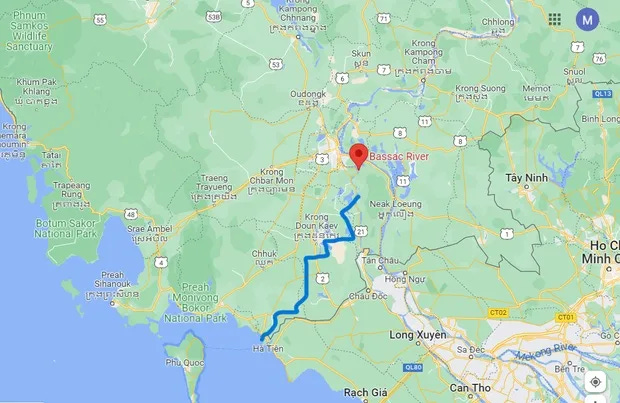Cambodia China-Back Canal
Funan Techo Canal will allow Cambodia to bypass Vietnam for its international trade and pull it even tighter into Beijing’s sphere of influence
By Richard S Ehrlich
Cambodia wants to divert Southeast Asia’s Mekong River into a planned US$1.7 billion, Chinese-financed shipping canal to reach a deep-sea port at Kep near Sihanoukville on southern Cambodia’s Gulf of Thailand coast.
The Funan Techo Canal would enable Cambodians to be “breathing through our own nose,” said newly elected Prime Minister Hun Manet, son and heir to long-time authoritarian former prime minister Hun Sen.
Cambodia, for the first time, could import and export goods by ship from its capital Phnom Penh’s port via the canal to a would-be deep-water port in Kep province on the Gulf of Thailand, opening onto the South China Sea.
Ships to and from Hong Kong, Singapore and other ports could reroute, or add shipping lanes, to Kep to access the canal if it increases trade. Shipping containers from those ocean-going vessels would be transferred by cranes at Kep to and from canal barges.
A successful Chinese-financed canal would also deepen Beijing’s economic, diplomatic and other links with Phnom Penh while lessening Cambodia’s dependence on Hanoi.
In 1994, the lack of a canal allowed Vietnam to block Cambodia’s shipping through the Mekong Delta because of a feud between the two countries.
Beijing reportedly signed the canal agreement with Phnom Penh under China’s Build-Operate-Transfer contract. Officials from China’s Belt and Road Initiative participated in the signing.
Cambodia “did not borrow money from China to build the canal,” said a delighted Prime Minister Hun Manet.
“Based on the contract for Funan Techo Canal, the Chinese company would manage the canal, including maintaining it and making a profit from charging for passage through the canal,” reported ThinkChina, a Singapore-based online information site.
“The Chinese company would transfer the management of the canal to the Cambodian government after a period of time, around 40 to 50 years. “The Funan Techo Canal is one among many other of China’s key infrastructure projects in Cambodia,” ThinkChina’s researcher Sokvy Rim said.
Blueprints reportedly portray the canal as 180 kilometers long and 100 meters wide upstream, tapering to 80 meters further south.
Its “consistent depth of 5.4 meters” would handle cargo ships up to 3,000 deadweight tonnage. Ships would sail through three watergates, under 11 bridges, and along 208-kilometers of sidewalk.
More than 1.5 million Cambodians live along the route. It is unclear how many would be displaced by the project and where they would go.
The canal is close to Cambodia’s coastal Sihanoukville Special Economic Zone, the country’s busy premier deepwater port which Chinese investment and its Belt and Road Initiative is boosting.
Also nearby, the US is locked in a feud with Cambodia over Ream Naval base because it received Chinese financing and is open to international shipping, which Washington fears could eventually include Chinese warships.
If dug, the Funan Techo Canal could negatively impact nearby Vietnam’s profitable Cai Mep and other ports close to Ho Chi Minh City along the Mekong Delta’s mouth, which also opens on the South China Sea.
Currently, when Cambodia uses the Mekong River to import raw materials from China, or export finished products to the US, Europe and elsewhere, those ships carrying millions of tons of material must pass through Vietnam’s Mekong Delta to link Phnom Penh and Cambodia’s other upriver ports with the South China Sea.
Vietnam had been hoping its Mekong mouth monopoly would profit Hanoi if it was sweetened for Phnom Penh. For example, earlier this year Cambodia and Vietnam signed a Treaty on Waterway Transportation to reduce restrictions on cross-border navigation, speed ships’ movements, streamline customs and immigration, and untangle other bureaucratic knots on the Mekong.
The Mekong flows southeast from China and Laos into Cambodia, and on through southern Vietnam to the South China Sea.
As the Mekong passes Phnom Penh, some water bulges into a Tonle Sap Lake. Nearby downriver, the relatively narrow Bassac appears as a “distributary,” draining the Mekong to fill the Bassac’s own flow southeast across Vietnam to the Mekong Delta and sea.
The canal links Kep to the Bassac River, where vessels can switch to the Bassac, which is sourced nearby at the Mekong. To flood the canal and keep cargo vessels afloat, the Bassac River may need much more water from the Mekong. That could negatively impact Vietnam’s Mekong Delta fishing areas, irrigation systems, and other riverside infrastructure and ecological systems.





